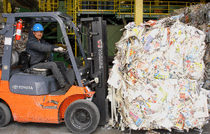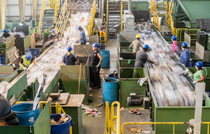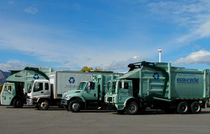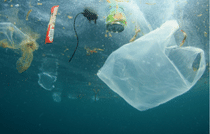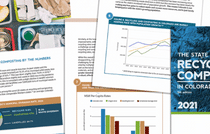Fast Fashion’s Hidden Peaks: How Our Wardrobes Build Mountains Abroad
As fast fashion churns out more clothes than the world can wear, mountains of textile waste are piling up around the world. Here’s how fast fashion drives pollution, labor abuses, and what’s being done to change it.

In northern Chile’s Atacama Desert, an unlikely landmark has emerged: mountains of discarded clothing. These piles—stretching across nearly 580 football fields—are made up of secondhand garments shipped from the United States and Europe, much of it never sold or worn.
This textile mountain is a byproduct of the global fast fashion machine, a system that churns out clothing faster and cheaper than ever before. The clothes arrive faster than they can be sorted, leaving behind a growing symbol of the global fast fashion crisis.
A System Built on Speed
Just a generation ago, designers released two major collections a year: fall/winter and spring/summer. Now, brands rely on flimsy fabrics and trend-gathering algorithms to collapse the design-to-production timeline from months to as few as 10 days. Spanish retailer Zara introduces about 35,000 new styles each year. China-based Shein eclipses even that, with an estimated 1.3 million products annually.
For consumers, it means the ability to copy an influencer’s outfit almost instantly. For the planet, it means staggering amounts of textile waste.
Fast Fashion’s Plastic Problem
The fashion industry generates 92 million tons of waste every year, and it’s growing. Much of it is plastic-based fabrics like polyester, nylon, and acrylic. Why plastic? Cost is one reason—it’s far cheaper than cotton. Plastic textiles also provide a new market for oil and gas companies. Today, we make everything from packaging to furniture to textiles out of plastic.
The consequences are everywhere. Synthetic fabrics shed microplastics when worn, washed, and dried, making them a leading source of microplastic pollution globally. Once discarded, these garments don’t biodegrade but rather break into smaller fragments that persist in ecosystems and even human bodies. For example, even well-intentioned clothing donations often end up in places like Chile’s textile mountain or Ghana’s “obroni wawu” (dead white man’s clothes) river.
Compounding the problem, many textiles contain harmful chemicals such as phthalates, PFAS, and lead—sometimes at levels hundreds of times above legal limits, posing risks for both factory workers and wearers.
The Human Cost of Fast Fashion
“Fast fashion is far from cheap—someone, somewhere, is paying the price.”
– Broken Threads & Twisted Yarns: Legislating the Reform of Fashion
Behind the low prices of fast fashion items are unsafe conditions and labor exploitation. In fast fashion factories, workers are often paid pennies per garment—sometimes just $0.02 to $0.06 apiece, translating to less than $6 an hour. Shein employees have reported grueling 18-hour days to meet quotas of 500 garments, with only one day off per month.
These injustices aren’t just happening abroad—a US Department of Labor investigation found garment workers in Southern California being paid as little as $1.58 an hour.
Policy Solutions on the Horizon
Governments are beginning to respond. Across Europe, reforms are underway to rein in the fashion industry. Emerging policies include:
- Banning the destruction of unsold clothes and requiring alternatives like donation or repurposing.
- Phasing out toxic “forever chemicals” such as PFAS in apparel.
- Mandating Producer Responsibility to hold textile companies financially accountable for the entire lifecycle of their products.
- Developing required eco-design standards that necessitate labeling on a product’s durability, repairability, recycled content, and supply chain transparency.
- Requiring microfiber filters to be installed in all new washing machines to reduce plastic pollution at the source.
In the United States, reform is moving more slowly, but progress is happening.
- California passed the first-in-the-nation Responsible Textile Recovery Act in 2024, requiring fashion companies to plan for how their products will be collected, recycled, repaired, and safely managed. They also passed protections for garment workers.
- New York introduced an Extended Producer Responsibility bill for textiles in 2025 (Senate Bill S3217A) that would require large fashion retailers to map supply chains, disclose impacts, and pay into a remediation fund.
- California and New York have both also introduced legislation to mandate microfiber filters on washing machines. A similar federal law was introduced in July 2025.
- California, New York, and Colorado have limited or banned the intentional use of PFAS in textiles and other products.
How You Can Reduce Your Fashion Footprint
Addressing textile pollution is one party we don’t want to be fashionably late to! Here are simple ways to look good while doing good:
- Choose wisely. Invest in well-constructed staples instead of cheap trends. Remember that while organic fibers are better than plastic fibers, they still have labor and environmental impacts.
- Shop secondhand. Check out local thrift shops and consignment stores. Boulder has a robust thrift and consignment shop scene, from Pig + Pearl (where Eco-Cycle currently brings all the clothing donated at the CHaRM) to Rags Consignment, Arc, Goodwill, and others. Online secondhand stores like Poshmark and ThredUp expand your options.
- Upcycle or repair. Add patches, adjust hems, or refashion old clothes to extend their life. Find inspiration in refashion blogs.
- Rent or borrow for special occasions. Services like Rent the Runway and Nuuly let you dress up without the waste.
- Recycle responsibly. Use textile recycling programs and avoid dumping clothes into donation bins that may just export waste overseas.
Examples such as the clothing heaps in Chile’s desert show the true cost of disposable fashion. They are stark reminders that while fast fashion makes trends accessible, its legacy is measured in mountains of waste, plastic pollution, and human exploitation.






